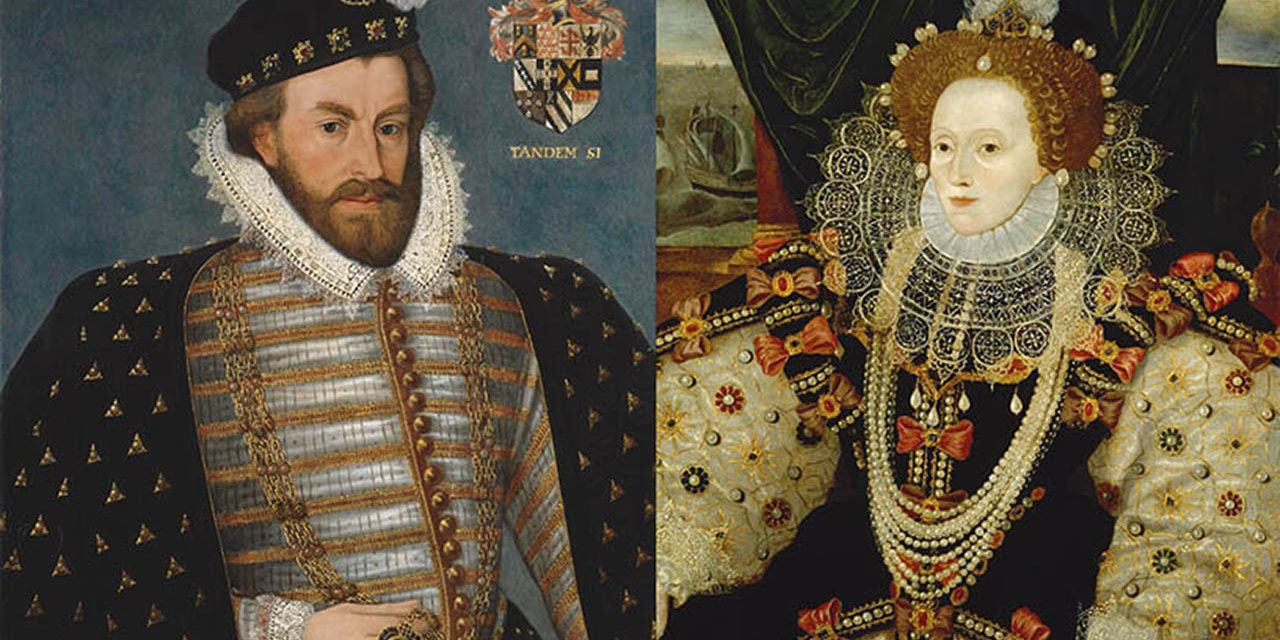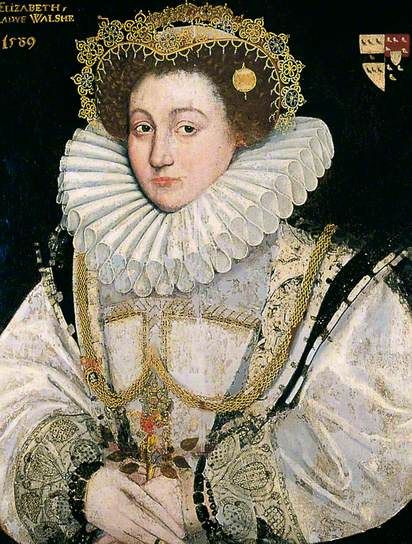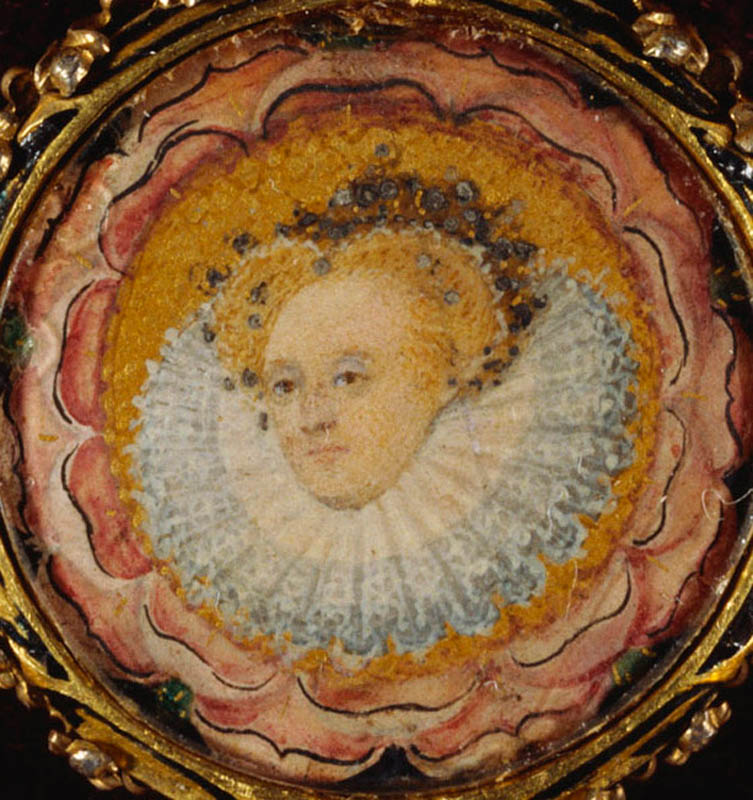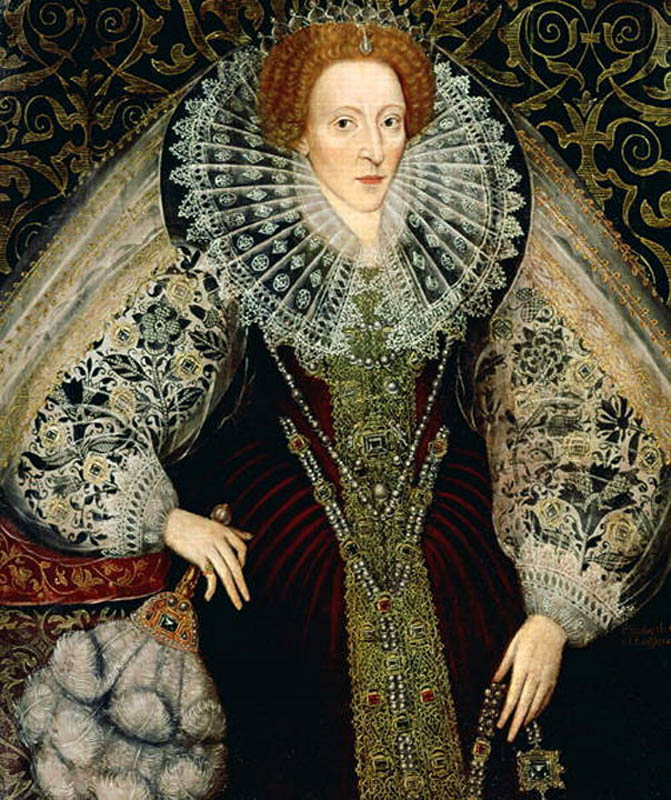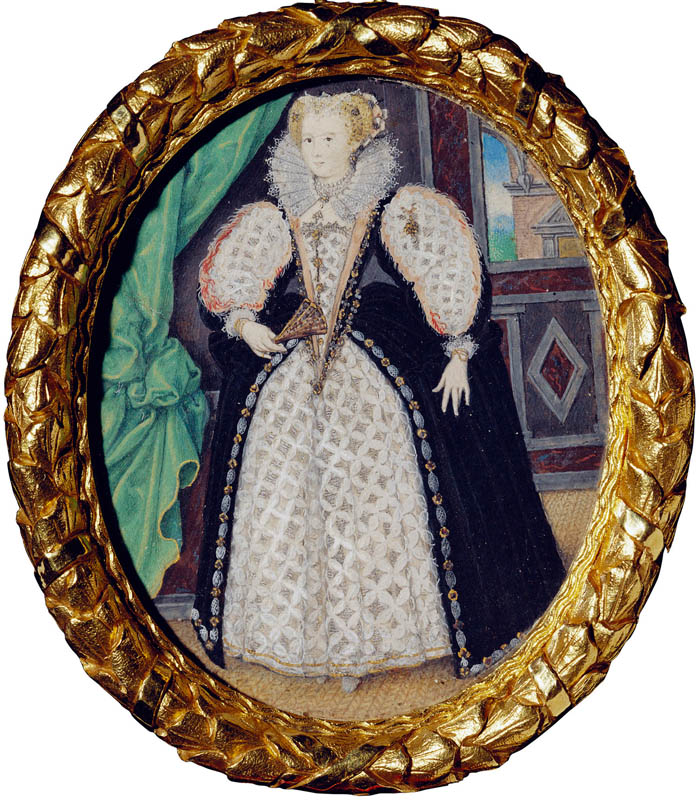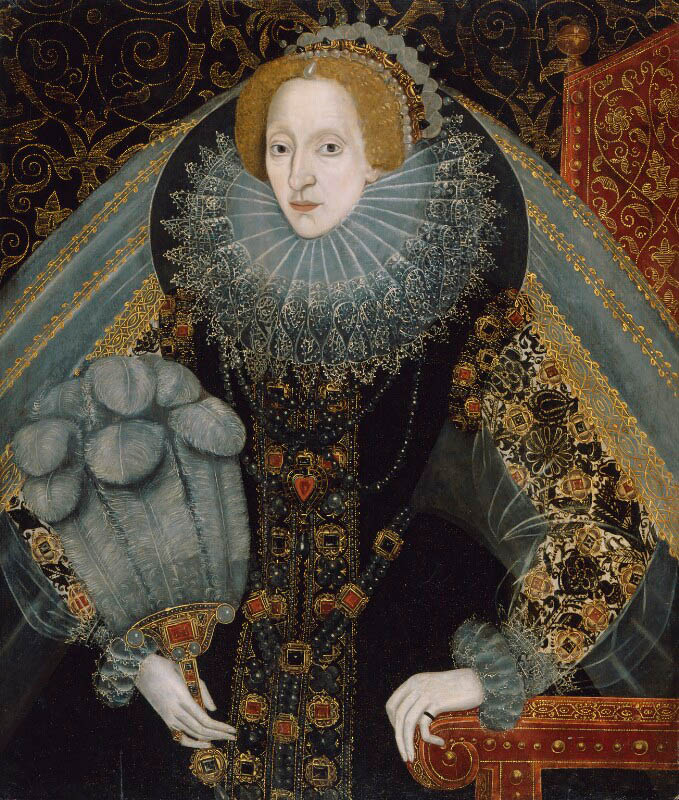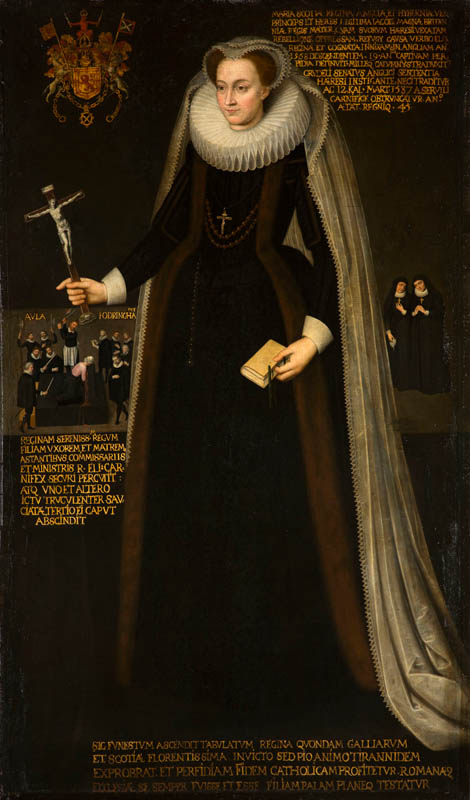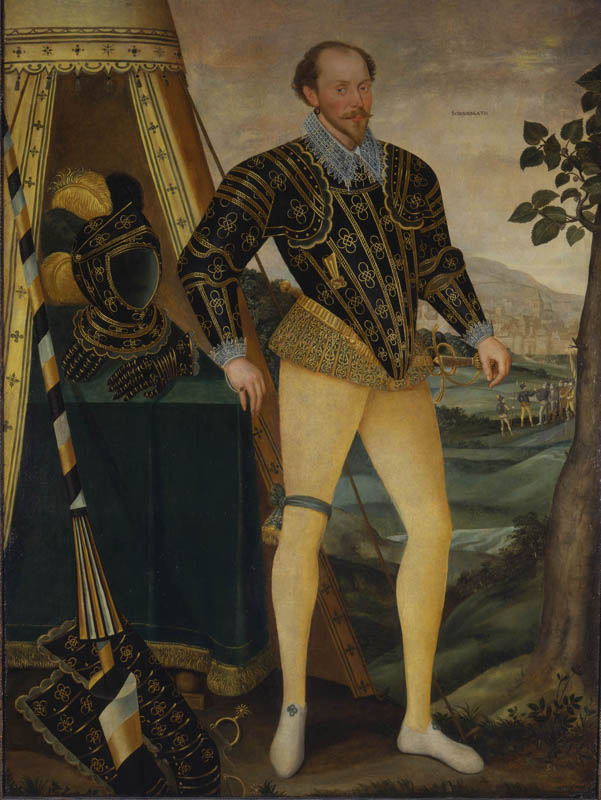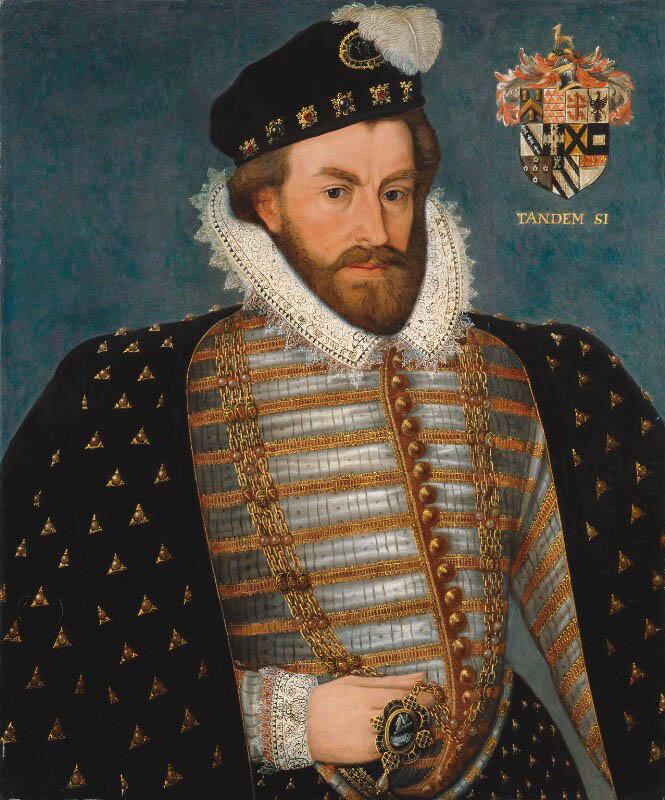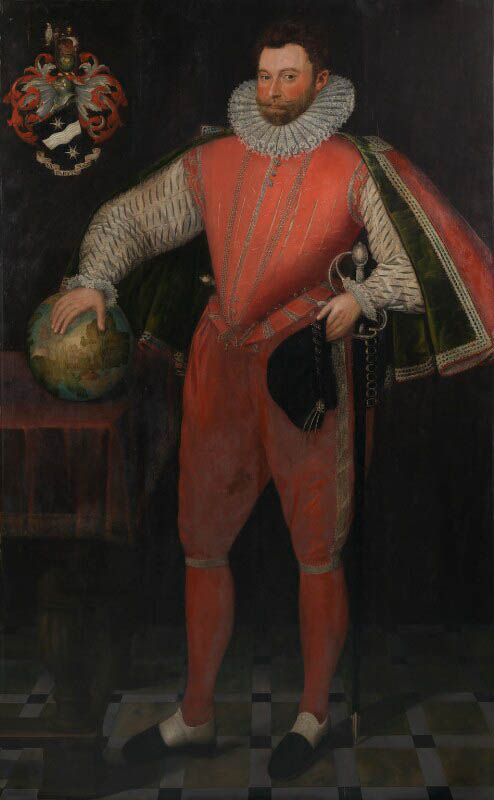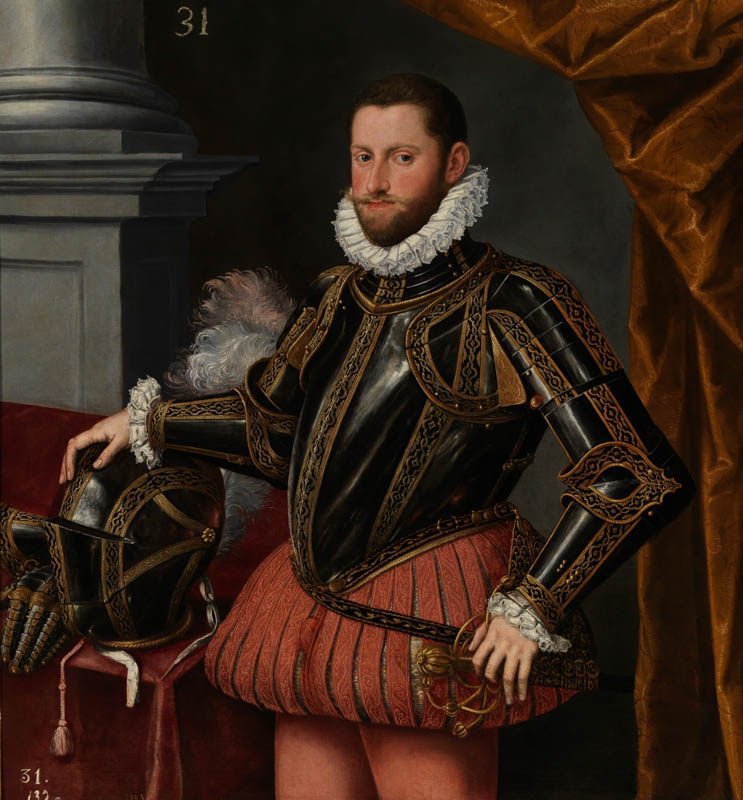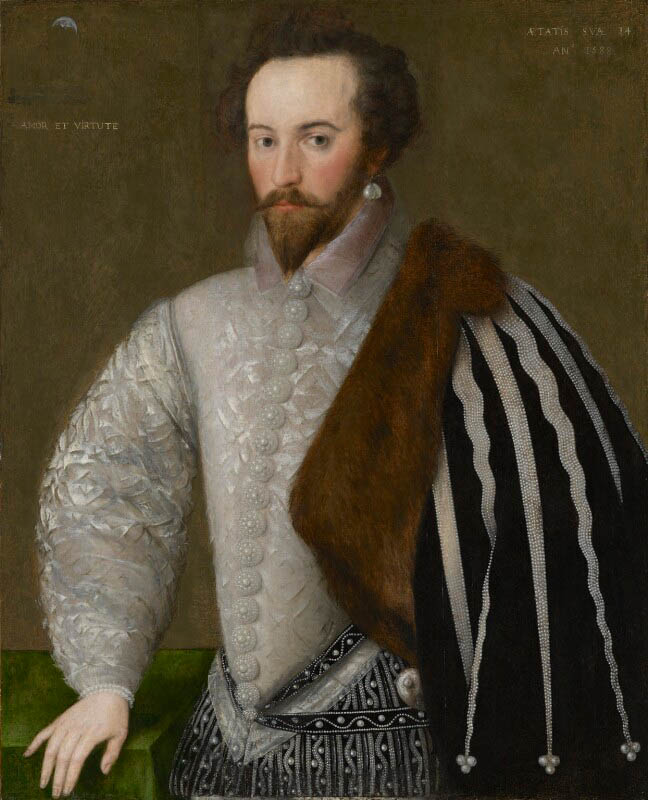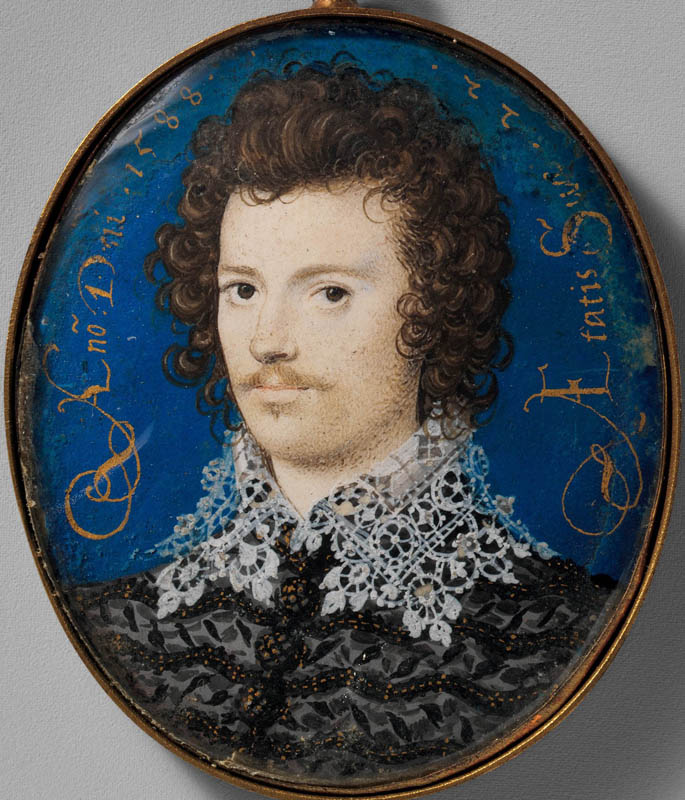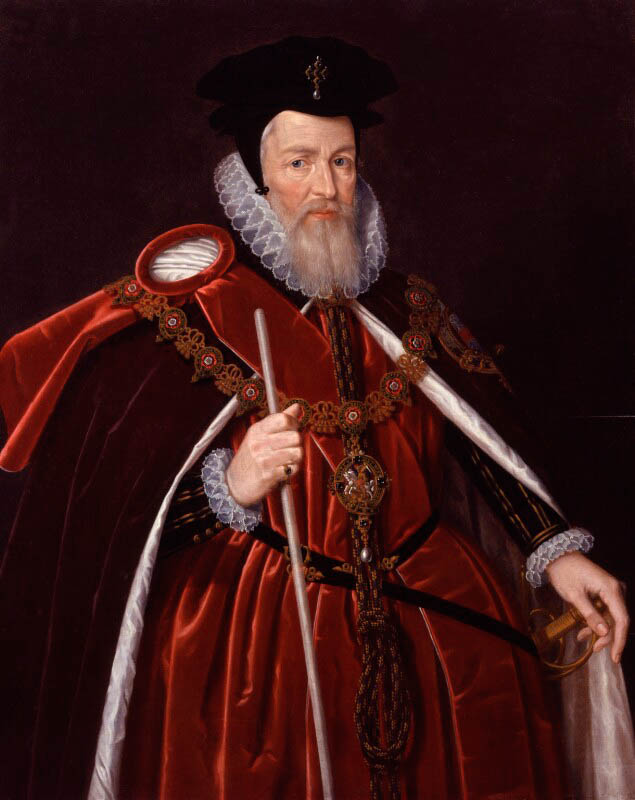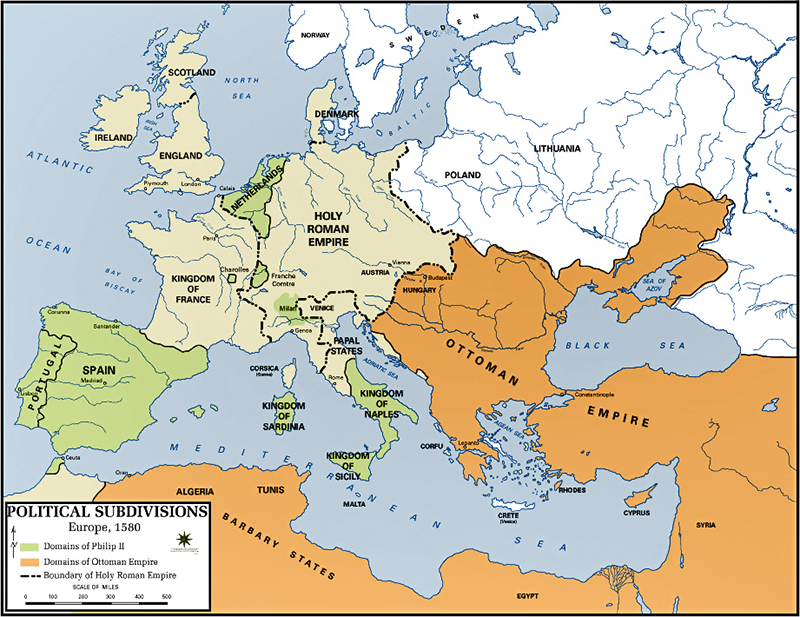OVERVIEW
1580s fashion featured a new, slender silhouette for men, and a contrasting, ever-expanding dimensionality for women. These fanciful styles signaled power, class, and currency.
In 1583, the pamphleteer Philip Stubbes published his best-known work, The Anatomie of Abuses. The text laments and lambasts contemporary vices such as prostitution, festivities, gluttony—and “How Pride of Apparell, is perpetrate & committed.” “There is such a confused mingle mangle of apparel and such preposterous excess thereof,” he wrote, “as every one is permitted to flaunt it out, in what apparel he lust himself, or can get by any kind of means” (Kuchta 17). He elaborated on this “confusion,” noting that it is almost impossible to distinguish between social stratums, since “any magistrate or officer in the commonwealth, go daily in silks, velvets, satins, damasks, taffetas, and such like, notwithstanding that they be both base by birth, mean by estate, and servile by calling.” The paragraph ends with a desperate call to a higher power: “God be merciful unto us” (Kuchta 17).
Although Stubbes represents a more conservative opinion, there was some truth to his maxims, given the fast-paced sartorial turnover fronted by Queen Elizabeth I (Fig. 1). At England’s Elizabethan court, like elsewhere in Europe, clothing was a currency of power, manipulation, and magnificence. As the Queen constantly redefined her preferences and expanded her political network, her courtiers eagerly and necessarily followed, mirroring their monarch to emphasize their devotion.
Gifted, recycled, painted, and reproduced, clothing traveled quickly, as did changes in trends. As Anna Reynolds writes in In Fine Style, it became a pan-European joke to mock the English for their chameleon-like approach to fashion (187). Efficient trade networks, pattern books, prints, courtiers, diplomatic marriages, and ambassadors paved new access and new inspirations. Fine silks were sourced from Italy and France, woolens from England, and linen from Flanders (Reynolds 187). In Spain, Reynolds notes, styles were comparatively consistent (187).
Visually, clothing only became more elaborate (Fig. 2), continuing preferences from the 1570s and anticipating the peak of the 1590s. Or, as the Cunningtons write in their Handbook of English Costume in the 16th Century, both men and women “enjoyed the restriction of an immense ruff, a tapering waist compressed by…stiff inflexible sleeves, and a fantastic ballooning of the hips” (11). The Cunningtons characterize the style as one of poised, posed “artificial restraint,” in a way that echoes contemporary political trends.
Although they were notoriously hard to enforce, 16th-century sumptuary laws dictated the clothes, colors, materials associated with each societal rank—and often prohibited “unnecessary” foreign goods (“Proclamation against Excess of Apparel by Queen Elizabeth I,” British Library). Purple silk and luxurious tissues like cloth of gold, for example, could only be worn by the royal family and select nobles (“Elizabeth I’s Proclamation Against Excess,” British Library). One can imagine these physically restrictive garments complemented the ideal of a well-ordered society envisioned by Stubbes and like-minded contemporaries.
Fig. 1 - Marcus Gheeraerts the Younger (Flemish, 1561-1636). Elizabeth I of England in Parliament Robes, 1585-90. Helmingham Hall: Stowmarket. Source: Wikipedia
Fig. 2 - Artist unknown (English). Queen Elizabeth I, ca. 1588. Oil on panel; 97.8 x 72.4 cm (38 1/2 x 28 1/2 in). London: National Portrait Gallery, NPG 541. Source: National Portrait Gallery
Womenswear
As the Elizabethan age wore on, the woman’s silhouette became increasingly exaggerated—and rigid. Through a combination of the queen’s thoughtful manipulation of her image and the availability of new materials through trade, a stylish woman in the 1580s was an expanded, elaborated version of her former self. She wore numerous layers, starting with the smock and stockings, to be then cloaked in a bodice (or “a pair of bodies”) and a kirtle (or skirt). Depending on her class and role, the process could take minutes or hours—according to one satirical playwright, “a ship is sooner rigged by far, than a gentlewoman made ready” (Tomkins Act IV, Sc. V.)
As Eleri Lynn explains, Atlantic voyages introduced whalebone, a pliable cartilage that was used to contour nearly all facets of an Elizabethan woman’s dress (52). A precursor to the corset, the bodice was outfitted with whalebone for stiffness and tied with stays (Vincent). It created a somewhat triangular shape, with a square neckline (Fig. 1). The neckline, which might be low and revealing, would then have been covered a partlet or a ruff (Cunnington 152). Young women may have also chosen to skip both and emphasize their décolletage, powdering their chests with white lead and painting blue veins (Reynolds 48).
If she wore a ruff, it could be a medium-sized cartwheel ruff or a wired collar (a shaped, standing collar) (Cunnington 168). An excellent example of a cartwheel ruff can be seen in a miniature by Nicholas Hilliard in the Royal Collection (Fig. 2). Completely encircled by the ruff, Elizabeth’s head emerges as a bud amongst petals.
A lady’s sleeves might be kept close-fitting, with padding and slashed areas to emphasize the luxurious fabrics (Cunnington 152). Spanish sleeves, which also become popular at this time, were a more voluminous alternative—so voluminous, in fact, that whalebone might be incorporated to maintain their shape (Lynn 51). A portrait of the Queen (Fig. 3) demonstrates the exaggerated, overabundant silhouette. The heavy brocade meanwhile contrasts with the delicacy of the openwork lace ruff, for a striking impression.
The greatest shift was in the farthingale, which determined the shape of the skirt, or kirtle. Where earlier decades had favored the conical, Spanish style, the 1580s found its infrastructure in the French or drum-shaped wheel farthingale, with wider-rimmed, squarer boning. The wheel farthingale was a hoop-like suspension, hovering around the hips to create an almost perpendicular angle at which the skirt would fall (Vincent). Hilliard’s 1589 Portrait of a Lady, perhaps Penelope, Lady Rich (1563-1607) (Fig. 4) shows Lady Rich posed stylishly in her French farthingale, her embellished stomacher and frontispiece forming a geometric impression of her body. Her hairstyle also aligned with the preference for hair that was coiled back, to expose the forehead. A portrait of Queen Elizabeth features very similar fashions (Fig. 5).
The skirt would be gathered and pinned to the farthingale. Stubbes, piqued by the fashion, complained, “yet they must have kirtles—for so they call them—of silk, velvet, grograin, taffeta, satin or scarlet, bordered with gards, lace, fringe, and I can not tell what” (Cunnington 149). Beneath the skirt, women wore stockings, usually made from wool or silk.
Fig. 1 - Flemish School. Lady Elizabeth Walshe, 1589. Oil on wood; 64.7 x 49.5 cm. York: York Art Gallery, YORAG : 516. gift from Mrs J. R. Johnson, 1948. Source: Art UK
Fig. 2 - Nicholas Hillard (English, 1547-1619). Elizabeth I (1533-1603), ca. 1583-87. Watercolor on vellum laid on plain card. RCIN 420021. Source: Royal Collection Trust
Fig. 3 - John Bettes the Younger (British, -1616). Elizabeth I of England, 1585-1590. Private Collection. Source: Wikipedia
Fig. 4 - Nicholas Hilliard (English, 1547-1619). Portrait of a Lady, perhaps Penelope, Lady Rich (1563-1607), ca. 1589. Watercolor on vellum laid on card; 5.7 x 4.6 cm. RCIN 420020. Source: Royal Collection Trust
Fig. 5 - Artist unknown. Queen Elizabeth I, 1585-1590. Oil on panel; 95.3 x 81.9 cm (37 1/2 x 32 1/4 in). London: National Portrait Gallery, NPG 2471. Given by wish of Sir Aston Webb, 1930. Source: NPG
Fashion Icon: Mary, Queen of Scots
Fig. 1 - François Clouet (French, 1520-1572). Mary, Queen of Scots (1542-87), ca. 1560-61. Oil on panel; 30.3 x 23.2 cm. Palace of Holyroodhouse, RCIN 403429. Source: Royal Collection Trust
Fig. 2 - British School (Stuart). Mary, Queen of Scots (1542-87), ca. 1610-40. Oil on canvas; 219.3 x 131.3 cm. Palace of Holyroodhouse, RCIN 404408. Source: Royal Collection Trust
Mary Stuart was briefly Queen Consort of France (1559-60) and Queen of Scotland from 1542 until 1567, when she was forced to abdicate. Cousin to Queen Elizabeth I, Mary fled to England for safety after this shift in power. However, as she had a claim to the English throne, was a Catholic alternative to the Protestant Elizabeth, and had an “appetite for the crown,” Mary posed a constant threat to her English cousin (Jenkins 135).
Given her perilous position (and her acclaimed beauty), Mary loomed large in political and sartorial imaginations. James Melville, the Scottish ambassador, compared the two queens in conversation with Elizabeth I:
“She desired to know of me what colour of hair was reputed best, and whether my queen’s hair or hers was best, and which of them two was fairest. I answered that the fairness of them both was not their worst faults. But she was earnest with me to declare which of them I judged fairest. I said she was the fairest queen in England and mine the fairest queen in Scotland. Yet she appeared earnest. I answered they were both the fairest ladies in their countries; that her Majesty was whiter, but my queen was very lovely.” (Melville 55)
Generally, Mary is most closely associated with the deuil blanc, a white, pleated barbe customary in French mourning. After the death of three family members, this choice allowed her to control her iconography and heighten her royal position as Dowager Queen of France and Queen of Scotland (Frye 48). She even complained of her cousin, “I perceive you like me better when I look sadly than when I look merrily, for it is told me that you desired to have me pictured when I wore the deuil.” She is often depicted—both in and after her lifetime—in this attire, as can be seen in this portrait in the Royal Collection (Fig. 1). Even after the mourning period, Mary often wore white gauze and transparent veils.
Sadly, many of Mary’s most “iconic” moments are associated with death—even her own. At her execution in 1587 (Fig. 2), Mary approached the scaffold in a striking outfit of black and red (the color of martyrdom), to emphasize her innocence. It is said she wore, “a gown of black satin printed…with a train, and long sleeves to the ground set with acorn buttons of jet garnished with pearl, and short sleeves of black satin cut with a pair of sleeves of purple velvet, whole under them a whole kyrtle of figured satin black, her petticote upper body’s unlaced in the back of crimson satin, and her patticote of crimson velvet…” (Norris 635).
Menswear
A stylish man’s wardrobe in the 1580s comprised many of the elements relevant across the sixteenth and seventeenth centuries. In specific pieces, the wardrobe might consist of jerkins, doublets, gowns, hose, breeches, nightgowns, cloaks, buskins, boots, pumps, bonnets, and flat caps.
In terms of silhouette, men took on slender proportions with select padding (Fig. 1). Compared to the early sixteenth century, the desired silhouette was “modest or compact” (Lynn 51). Codpieces, gowns, and enormous shoulders and sleeves fell out of fashion (Lynn 56). Instead, high waists and long legs met neat torsos and fanciful shoulders.
Yet despite a generally slim look, the 1580s favored the Dutch “peascod belly,” a dip that inflated at the girdle (Cunnington 90) (Fig. 2). The “peascod” shape appeared in doublets—and armor (Fig. 3)—and was achieved through a type of padding called “bombast.” As George Gasciogne mocked in 1589, gentlemen adorned themselves with various protruding elements: “Thy bodies bolstered out, / With bombast and with bagges, / They roales, thy ruffs, thy cauls, they coifes, / They jerkins and thy jagges” (Cunnington 12). In a 1581 portrait (Fig. 4), an elegant Sir Frances Drake is dressed in a satin, peascod doublet paired with stylish venetians worn to the knee.
The first layer would have been a linen shirt, intended to be hidden under a doublet, then a cloak. Crafted in taffeta, velvet, satin, brocade for the wealthy, a doublet) might have wide or slim sleeves (Cunnington 91-93). The doublet could also be made in fustian, canvas, rash, or leather, as less costly options (Cunnington 93). Generally, these were worn buttoned up to the neck (Lynn 56). Similar in shape and purpose was the “jerkin,” an outer-garment inspired by military-wear and often made of leather. It was worn, more or less, like a contemporary vest. The cloak became increasingly fashionable at the end of the sixteenth century, as well. Often vented, it flared out from the shoulders (Cunnington 103).
Trunk hose (breeches) would have been attached to the doublet. A particularly fashionable style was melon hose, which puffed out around the thighs. Canions were then worn under the melon hose, reaching to the knee (Cunnington 121). Venetians were an alternative style of hose that were loose fitting and actually reached the knee. Below the knee, men wore stockings, which were often fastened with ribbons or garters. In the Prado’s ca. 1580 portrait (Fig. 5), paned trunk hose appear with peascod armor.
Fig. 1 - Daniël van den Queborne (Dutch, 1552-1605). Sir William Drury, of Hawstead, Suffolk (1550-1590), 1587. Oil on canvas; 238.1 x 156.2 cm (93 3/4 x 61 1/2 in). New Haven: Yale Center for British Art, B1973.1.15. Paul Mellon Collection. Source: YCBA
Fig. 2 - Artist unknown. Sir Christopher Hatton, 1589. Oil on panel; 78.7 x 65.9 cm (31 x 26 in). London: National Portrait Gallery, NPG 2162. Purchased, 1927. Source: NPG
Fig. 3 - British Painter. Sir John Shurley of Isfield (1565–1632), 1588. Oil on wood; 90.8 x 74.6 cm (35 3/4 x 29 3/8 in). New York: The Metropolitan Museum of Art, 51.194.2. Gift of Kate T. Davison, in memory of her husband, Henry Pomeroy Davison, 1951. Source: The Met
Fig. 4 - Artist unknown. Sir Francis Drake, ca. 1581. Oil on panel; 181.3 x 113 cm (71 3/8 x 44 1/2 in). London: National Portrait Gallery, NPG 4032. Purchased, 1957. Source: NPG
Fig. 5 - Manner of Alonso Sánchez Coello (Spanish, 1531-1588). Archduke Diego Ernesto of Austria, ca. 1580. Oil on canvas; 116 x 109 cm. Madrid: Museo del Prado, P001145. Source: Prado
Fig. 6 - Artist unknown (English). Sir Walter Ralegh (Raleigh), 1588. Oil on panel; 91.4 x 74.6 cm (36 x 29 3/8 in). London: National Portrait Gallery, NPG 7. Purchased, 1857. Source: NPG
In terms of decoration, many garments were decorated with cut-work—when portions of material were removed and replaced with needlework—or embroidery in colored silks or silver or gold thread (Cunnington 13-14). “Slashing” – symmetrical slashes that often revealed contrasting-colored fabric underneath – and “pinking”—smaller, shaped cuts—might also dapple a garment. Sir Walter Raleigh’s doublet (Fig. 6) is covered with decorative slashing that reveals a white lining; his cloak is sable-lined and the surface is encrusted with seed pearls.
Of course, a collar completed the outfit—in the form of either a falling band or a ruff. The lace-decorated falling band turned down over the collar of the doublet and is visible in a 1588 portrait by miniaturist Nicholas Hilliard (Fig. 7). The ruff, on the other hand, was starched and goffered for a fluted appearance (Cunnington 112). In the 1580s, the ruff was mid-sized (Fig. 8) or platter-sized (Fig. 9) and was usually worn closed (Cunnington 112).
Fig. 7 - Nicholas Hilliard (English, 1547-1619). Portrait of a Young Man, Probably Robert Devereux (1566–1601), Second Earl of Essex, 1588. Vellum laid on card; 4 x 3.3 cm (1 5/8 x 1 3/8 in). New York: The Metropolitan Museum of Art, 35.89.4. Fletcher Fund, 1935. Source: The Met
Fig. 8 - Artist unknown. William Cecil, 1st Baron Burghley, after 1587. Oil on panel; 113 x 91.1 cm (44 1/2 x 35 7/8 in). London: National Portrait Gallery, NPG 362. Source: NPG
Fig. 9 - Artist unknown (British). Sir Henry Unton, 1586. Oil on panel; 57.8 x 45.1 cm. London: Tate, T00402. Source: Tate
CHILDREN’S WEAR
As is consistent with the rest of the century, children in the 1580s followed the fashions sported by their parents (Fig. 1). After a period of swaddling, young children—regardless of gender—wore skirted fashions, until around the age of six. At that point, boys experienced a rite of passage called “breeching,” wherein they received clothes in imitation of their father’s. As Anna Reynolds notes, “breeching” was a significant milestone, delineating the transition from the nursery, where women nurtured them, to a more adult world, full of masculine diversions (Reynolds, “Dressing Children”).
Fig. 1 - Sofonisba Anguissola (Italian, 1530s–1625). Giuliano II Cesarini aged 14, 1586. Oil on canvas; 186 × 115 cm (73.2 × 45.3 in). Private Collection. Source: Wikipedia
References:
- Ashelford, Jane. A Visual History of Costume: The Sixteenth Century. London: Batsford, 1983. http://www.worldcat.org/oclc/748457696.
- Cunnington, C. Willett, and Phillis Cunnington. Handbook of English Costume in the Sixteenth Century. London: Faber and Faber, 1954. http://www.worldcat.org/oclc/362761.
- “Elizabeth I’s Proclamation Against Excess.” The British Library. Accessed July 23, 2019. https://www.bl.uk/learning/timeline/item126628.html.
- Frye, Susan. Pens and Needles: Women’s Textualities in Early Modern England. Material Texts. Philadelphia: University of Pennsylvania Press, 2010. http://www.worldcat.org/oclc/941085883.
- Jenkins, Elizabeth. Elizabeth the Great. New York: Coward-McCann, 1960. http://www.worldcat.org/oclc/1810094.
- Kuchta, David. The Three-Piece Suit and Modern Masculinity England, 1550-1850. Berkeley: University of California Press, 2002. http://site.ebrary.com/id/10048947.
- Lynn, Eleri. Tudor Fashion. New Haven: Yale University Press, 2017. http://www.worldcat.org/oclc/973159773.
- Melville, James. Memoirs of His Own Life. London: Chapman & Dodd, 1922. http://hdl.handle.net/2027/njp.32101062103583.
- Norris, Herbert. Tudor Costume and Fashion. Mineola, N.Y: Dover Publications, 1997. http://www.worldcat.org/oclc/1051611027.
- “Proclamation against Excess of Apparel by Queen Elizabeth I.” The British Library. Accessed July 23, 2019. https://www.bl.uk/collection-items/proclamation-against-excess-of-apparel-by-queen-elizabeth-i.
- Reynolds, Anna. In Fine Style: The Art of Tudor and Stuart Fashion. London: Royal Collection Trust, 2013. http://www.worldcat.org/oclc/824726826.
- Richardson, Catherine. Clothing Culture, 1350-1650. New York: Routledge, 2017. http://www.worldcat.org/oclc/976442537.
- Stubbes, Philip. “The Anatomy of Abuses by Philip Stubbes, 1583 – The British Library.” Accessed July 23, 2019. https://www.bl.uk/collection-items/the-anatomy-of-abuses-by-philip-stubbes-1583.
- Tomkins, Thomas. “Lingua, or, The Combat of the Tongue, and the Five Senses for Superiority a Pleasant Comoedy.” Accessed July 23, 2019. http://ota.ox.ac.uk/tcp/headers/A62/A62894.html.
- Vincent, Susan J. The Anatomy of Fashion: Dressing the Body from the Renaissance to Today. English ed. Oxford: Berg, 2009. http://www.worldcat.org/oclc/785875294.
- Welch, Evelyn S. Fashioning the Early Modern: Dress, Textiles, and Innovation in Europe, 1500-1800. Pasold Studies in Textile History 18. Oxford: Oxford University Press, 2017. http://www.worldcat.org/oclc/975099774.
Historical Context
Wikipedia: 1580-1589
Rulers:
- England: Elizabeth I (1558-1603)
- France: Henry III (1574-1589)
- Spain: Phillip II (1556-1598)
Historical Map of Europe 1580. Source: Emerson Kent
Events:
- 1582 – Pope Gregory XIII implements the Gregorian Calendar.
- 1583 – The Queen Elizabeth’s Men troupe of actors is ordered to be founded in England.
- 1584 – The Maronite College is established in Rome.
Timeline Entries
Primary/Period Sources
Resources for Fashion History Research
To discover primary/period sources, explore the categories below.
Have a primary source to suggest? Or a newly digitized periodical/book to announce? Contact us!
Digitized Primary/Period Sources
Secondary Sources
Also see the 16th-century overview page for more research sources… or browse our Zotero library.

